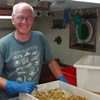General Description
Carapace length:width ratio 3:4. First 2 anterolateral lobes truncate, third sharp and fourth right-angled, margins of all marked with minute beads. Few scattered hairs on anterolateral regions of carapace.
Biology
Whereas many crabs will attempt to escape when disturbed or captured, pilumnud crabs play dead, curling their legs up to look as inconspicuous as possible. Their camouflage makes them difficult to see even when rocks are turned. Pilumnids are among the most difficult of crabs to identify to species in southern Australia, and close attention to the structure of the first pleopod (gonopod 1) of male specimens will be required to separate some closely related species.
Habitat
Estuarine, mud flats under stones, lower intertidal, to 13 m depth.
Soft substrates
Coastal shores
Distribution guide
Southern temperate oceans, including New Zealand and south-eastern Australia.
Species Group
Depth
Shore (0-1 m)
Shallow (1-30 m)
Water Column
Max Size
Diet
Organic matter
Harmful
Not harmful but a nip from claws could be painful.
Commercial Species
No
Global Dispersal
Recorded in Australia
Species Code
MoV 1596
Conservation Status
- DSE Advisory List : Not listed
- EPBC Act 1999 : Not listed
- IUCN Red List : Not listed






